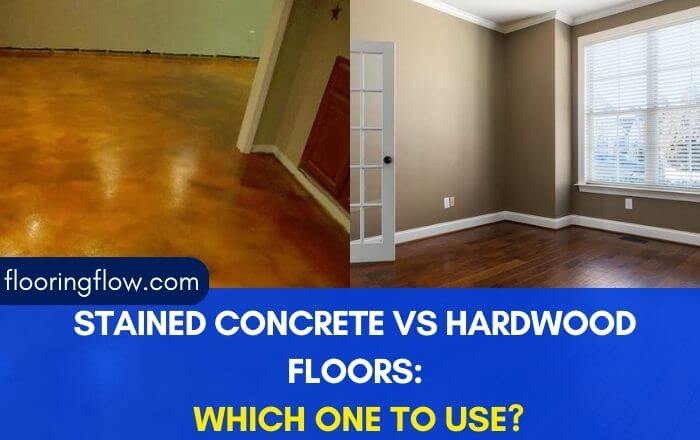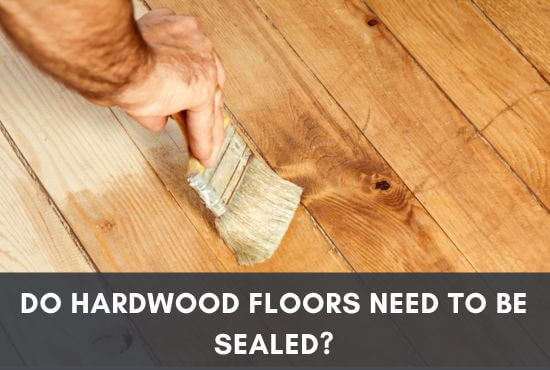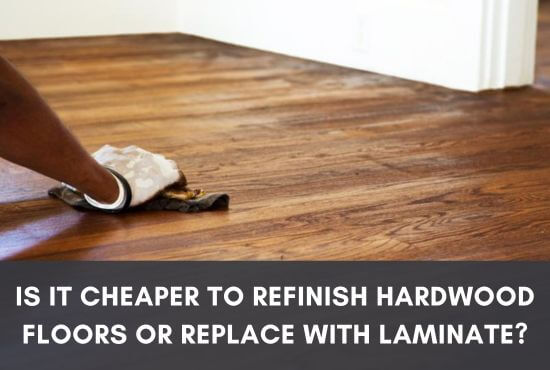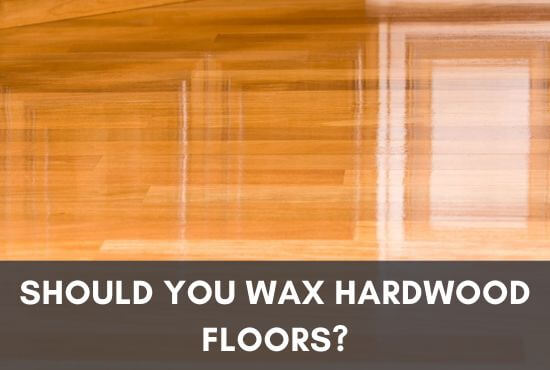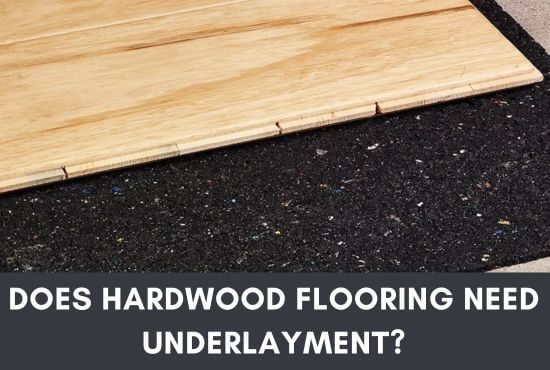In my personal experience with home flooring projects, I’ve noticed a growing trend in indoor concrete floors gaining popularity. While many individuals are embracing this modern concept, traditionalists still hold a preference for classic hardwood floors.
The ongoing debate between these two options has left many homeowners unsure about which path to take when it comes to their renovation projects or selecting new flooring for their homes.
To provide some clarity, I’m going to share with you a detailed comparison on stained concrete vs hardwood floors based on my DIY projects.
While concrete floors are extremely durable and quite cheap, they do not give any attractive appearance even after staining. Similarly, hardwood floors are extremely good in appearance but they are very expensive and not as durable as concrete.

Therefore, choosing the right one for your indoor floors depends on what you are trying to achieve and how much you are ready to invest financially and physically.
If you are intrigued by this topic and want to know more, keep on reading so you get an in-depth review of stained concrete versus hardwood floors.
Table of Contents
Which Is Better: Stained Concrete Or Hardwood Floors?
Working on different DIY projects, I used both hardwood and stained concrete flooring options. Let me share with you how they worked for me.
Hardwood Floors
Working with hardwood floors has been a truly rewarding journey in my DIY endeavors. These floors are crafted from beautiful hardwoods, cut into boards and planks that are a joy to install.
The variety available is astonishing, from the inviting warmth of oak to the opulent richness of mahogany.
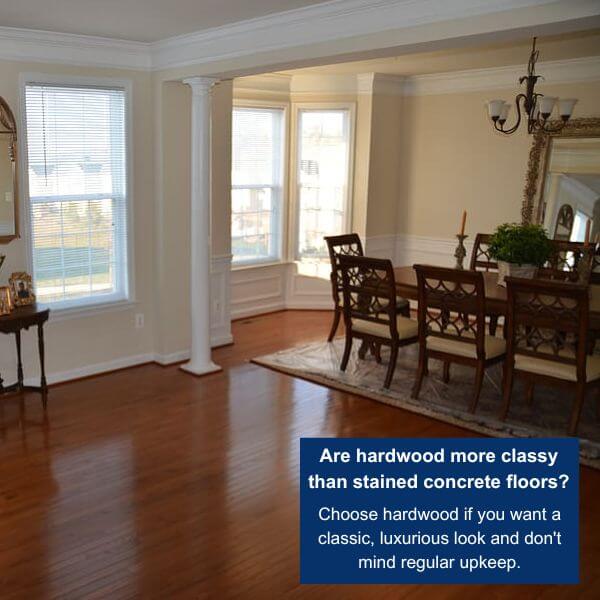
Hardwood floors bring a unique and luxurious feel to any space. They infuse your home with the timeless charm of wood, and the range of colors, textures, and sizes offers a world of design possibilities.
Pro Tip: Maintenance hack – sweep hardwood floors daily to prevent scratches from debris.
One interesting aspect is that not all hardwood is the same. Some types have undergone treatments to boost their durability and make them resistant to daily wear and tear.
After installation, the sanding and finishing process not only enhances the wood grain’s clarity but also adds a protective layer that keeps the floors looking pristine for years to come.
If you’re considering hardwood but have a concrete subfloor, learn about installing engineered hardwood on concrete floating for a seamless transition.
Stained Concrete Floors
Talk about stained concrete, it’s been a surprising and delightful discovery in my DIY projects.
Traditionally, concrete was thought of as strong but rather plain, often used outdoors for practical purposes. However, it has found a new life indoors.
The versatility of stained concrete is truly remarkable. It starts as a rough and tactile material, but with the magic of staining and polishing, it can be transformed.
Staining allows you to choose from a wide array of colors and textures, which means you can create floors that perfectly match your taste.
Stained concrete floors offer a modern, minimalist look that complements various design aesthetics.
They are impressively durable and can withstand heavy traffic without showing signs of wear and tear. Maintenance is a breeze, making them a practical choice for a variety of DIY projects.
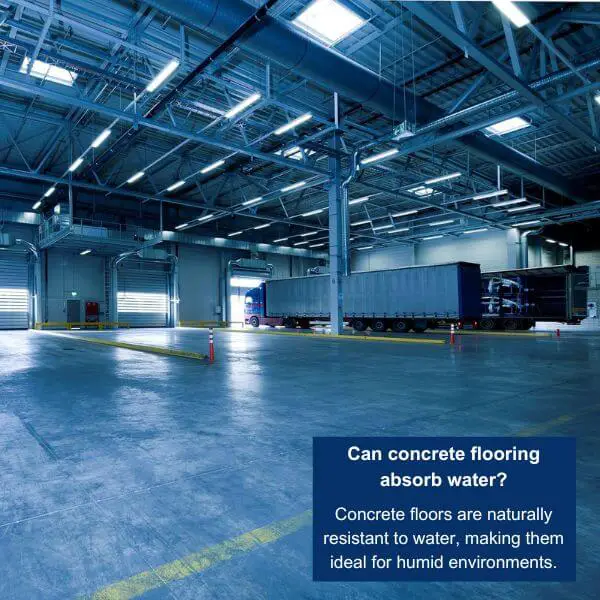
When it comes to deciding between hardwood and stained concrete for your DIY projects, it all comes down to your personal style, budget, and how much maintenance you’re comfortable with.
Hardwood floors exude classic luxury but require a bit more care. On the flip side, stained concrete offers durability, versatility, and easy upkeep. Your choice should align with the look and practicality you want for your project.
Get to know the importance of the right underlayment for engineered hardwood on concrete.
Stained Concrete Vs Hardwood Floors : A Detailed Features And Benefits Comparison
Having had the opportunity to work with both stained concrete and hardwood floors in various construction projects, I’d like to provide a detailed comparison of their features and benefits to help you make a wise decision when it comes to selecting the right flooring for your house.
While both of these materials are very strong, durable, and efficient flooring options, they have some pros and cons over each other which I will discuss below.
Therefore, stay connected and continue reading in detail so you are well aware of the situation at the end.
Variety
Hardwood offers a fantastic range of options when it comes to colors, textures, and patterns. You can’t change the inherent patterns in the wood, but that’s hardly an issue because there’s such a wide variety of wood types available.
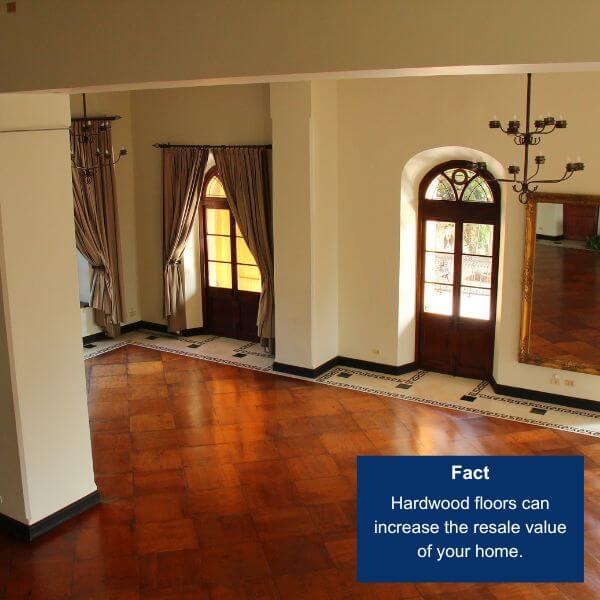
Whether you prefer darker tones like maple, mahogany, or walnut, or lighter shades like oak hardwood floors, you’ll find a suitable option. Plus, you can even stain hardwood floors to achieve precisely the color you desire, increasing the resale value of your home.
Go through the detailed comparison of maple versus oak floors.
This customization ability is a big advantage, allowing you to align your floors with your overall decor theme. Whether you fancy red, orange, brown, or even blue, staining can make it happen.
Now, let’s talk about stained concrete. In my projects, I’ve discovered that concrete floors are equally versatile. They offer an almost limitless palette of colors and patterns. Whether you want a subtle gray or a bold coral pink or parrot green, concrete can accommodate your vision.
Texture-wise, concrete is quite adaptable too. You can make it look like polished marble or opt for a matte finish. If you prefer a glossy sheen, that’s achievable as well.
Explore which finish suits best on hardwood floors: Matte Vs Satin Or Satin Vs Semi Gloss.
However, it’s worth noting that concrete doesn’t quite mimic the natural warmth and texture of wood. If you’re aiming for that classic wooden look, concrete might not be your best choice.
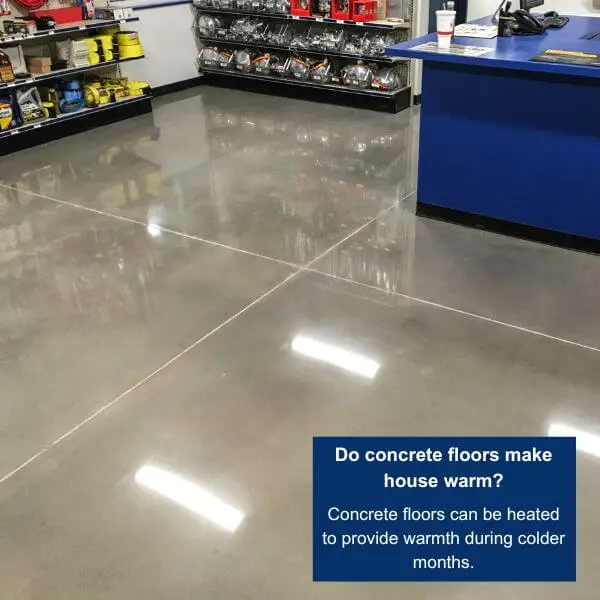
Suggestion: Invest in area rugs to add warmth and comfort to your concrete flooring.”
Both hardwood and concrete have their strengths. Hardwood provides a wide range of wood types and staining options, making it highly customizable. On the other hand, concrete comes with an extensive array of colors and textures but can’t quite replicate the warmth of wood.
Don’t Miss: Can You Glue Hardwood Flooring To Concrete?
Maintenance
Based on my personal background in various do-it-yourself projects, I want to emphasize the importance of choosing flooring that you can easily maintain.
Neglecting maintenance can lead to premature damage, which is a costly mistake. Let’s discuss the maintenance of hardwood and concrete floors, highlighting what worked well for me.
Hardwood floors are relatively straightforward to maintain but require daily attention. Regular dry-mopping and occasional vacuuming help keep dust at bay. Wet mopping every few weeks helps maintain cleanliness and shine.
While polishing every few months is recommended for maintaining that glossy look, it’s optional. There are also polishing cleaners available that can serve a dual purpose.
The crucial maintenance step for hardwood is refinishing, typically needed only every 3-5 years.
This process recoats the floors with a protective finish to ensure their long-term durability. If you’ve had proper installation, your hardwood floors should stay in good shape without constant issues.
When it came to concrete floors, I found them impressively easy to maintain. Unlike hardwood, you only need to mop or vacuum them once a week due to their seamless surface.
Dust and dirt don’t accumulate in tiny spaces because there aren’t any. Concrete floors are inherently sturdy and don’t require polishing, buffing, or refinishing. They can handle daily wear and tear quite well.
Considering aesthetics, concrete floors only need staining for a specific look. A single staining session can last 5-6 years or more, so you won’t need to refresh it frequently.

However, if you’re planning a renovation and want to change the floor’s appearance, you can opt to re-stain it between these periods, although this is optional and not part of regular maintenance.
Maintaining hardwood floors requires more frequent attention, including cleaning and occasional polishing and refinishing.
On the other hand, concrete floors are impressively low-maintenance. requiring less frequent cleaning and no need for polishing or refinishing. This ease of maintenance can be a significant factor when deciding on the right flooring for your project.
Durability
When it comes to flooring, durability is absolutely crucial. You don’t want your floors giving out under daily wear and tear.
Luckily, I’ve found both hardwood and concrete to be incredibly tough and reliable options.
These floors are impressive in terms of strength and durability. I can’t deny the fact that hardwood floors can often last close to 100 years, an impressive lifespan.
That’s a rarity in the world of flooring options. Plus, they can handle a lot of foot traffic without a hitch.
But there’s a catch. Hardwood floors require some extra tender loving care. You need to refinish and stain them to keep them in top shape.
If you neglect this step, the bare wood surface can quickly get damaged, and you might lose a significant portion of their lifespan.
One thing to keep in mind is that hardwood isn’t the best when it comes to moisture. It has a porous surface that can absorb moisture, leading to various issues and potential damage, especially in places like kitchens or bathrooms.
Excess moisture can be a real problem and can even damage them to the point of no return.

Concrete, on the other hand, is a durability champion. It can withstand heavy pressure and traffic, and it has an impressive lifespan even without fancy treatments like finishing or polishing.
Admittedly, concrete doesn’t last quite as long as hardwood, typically around 20 years. However, it has a unique advantage when it comes to water resistance.
Unlike hardwood, concrete doesn’t show immediate signs of weakness or damage when exposed to water.
It can absorb moisture over time, which can make the surface softer and lead to depressions, but it’s a slower process compared to hardwood.
On the flip side, extreme dryness can cause concrete to crack. However, concrete can handle sunlight and UV exposure without any issues.
One of the things I love about concrete is that it remains virtually scratch and scuff-free. You won’t find yourself sanding or buffing it regularly to keep it looking good.
While concrete may not match hardwood in terms of lifespan, it demands significantly less maintenance. You won’t be dealing with frequent repairs, making it a practical choice for the long haul.
Hardwood and concrete both are suitable for different preferences. However, when it comes to maintenance costs and overall ease of upkeep, concrete stands out as the winner.
It’s a smart investment that requires less effort to keep in top shape.
Explore: Is It Cheaper To Refinish Hardwood Floors Or Replace With Laminate?
Comfort
Comfort is a big deal when it comes to flooring. Nobody wants to walk on something that feels uncomfortable and causes discomfort in their feet or legs.
I must say, hardwood is a pleasant surprise in terms of comfort. Many people, including myself, consider it one of the coziest flooring options while still being strong and durable.
Part of its charm is how it’s installed on subflooring, which allows for a certain level of compression. This means you won’t feel like you’re walking on a stiff or rigid surface.
What’s even better is that this compression eases the pressure on your muscles and joints. If you have any discomfort while walking, hardwood floors can actually provide some relief.
Another great aspect of hardwood is its temperature. It remains cool throughout the year. While some might see this as a downside, it’s actually a benefit.
You can always put on socks if the floor is too cold, but dealing with a scorching hot surface in the summer is much less comfortable.
Surprisingly, stained concrete floors are not as uncomfortable to walk on as you might think. The concrete surface isn’t as rough as you might imagine.
However, it doesn’t offer any compression, so if you have joint or muscle issues, it might not be the best choice as it won’t alleviate any discomfort.
One downside of concrete is its temperature. It can become quite hot underfoot. Regardless of the season, concrete can absorb heat from the environment or the sun, making it uncomfortable to walk on barefoot.
In the winter, you might be able to tiptoe on it, but in the summer, walking barefoot on concrete is a no-go. Standing on concrete barefoot is uncomfortable in any season for the same reason.
Therefore, I can confidently say that hardwood floors are the winners in terms of comfort.
They’re softer, cooler, and much more pleasant to walk on. Concrete, on the other hand, is hard, hot, and not at all suitable for barefoot walking.
Cost
As reported by Forbes, the average cost of hardwood floor starts from $6 to $23 per square foot. This cost typically covers all aspects of the installation except for staining and finishing, which can add another $1,000 to $2,000 depending on the size of the area.
Hardwood has a reputation for being on the pricier side, but that’s not the whole story. The cost of hardwood flooring can vary widely.
However, it’s worth noting that there are more affordable hardwood options available. If you’re willing to go for basic variants, you can manage to keep your final bill from soaring too high.
The cost of stained Concrete, on the other hand, typically ranges from $2 to $6 per square foot including all the necessary processes. This price usually covers staining costs and any basic or complex designs you might want. It may go up to $20 per square foot as per the stain type and design of concrete.
Concrete offers excellent affordability, making it a practical choice for those with a mid-range cost. It’s an option that can fit comfortably within your financial constraints.
What I encountered is that both hardwood and concrete have their cost considerations.
Hardwood can be more expensive, but it’s not out of reach if you opt for more affordable varieties.
Concrete, on the other hand, is generally quite affordable, making it a sensible choice if you want quality without overspending.
You May Find Helpful: Is It Cheaper To Refinish Hardwood Floors Or Carpet?
Which Works Best For You?
If you value durability, easy maintenance, and have a tighter spending limit, stained concrete floors might be your best choice. They offer modern aesthetics but come with a slightly harder surface to walk on.
On the other hand, if you prioritize classic luxury, are willing to invest more upfront, and seek comfort underfoot, hardwood floors are the way to go.
However, be ready for regular maintenance to preserve their appearance and protect against moisture.
In short, pick stained concrete for durability and affordability with a modern look, or opt for hardwood if you desire classic luxury and are willing to invest in both upfront costs and maintenance.
Your choice should match your taste preferences, budget, and maintenance commitment.
Conclusion
After the entire discussion on stained concrete vs hardwood floors, it is clear that both hardwood and stained concrete are very efficient flooring options.
However, choosing the right one is extremely important and only you can do that.
Using a detailed comparison above, make sure you choose the correct type of flooring which suits your flooring goals to make it appealing, yet long lasting.

As a co-creator of FlooringFlow.com, Emma Sophia comes on board to answer all your questions related to any flooring problems. Together with John Henry, she’s gained extensive experience in fixing many flooring problems in their own house as well as in friends and family’s. Now, she wants to share her knowledge that she gained during floor remodeling, restoring, and DIY projects.

